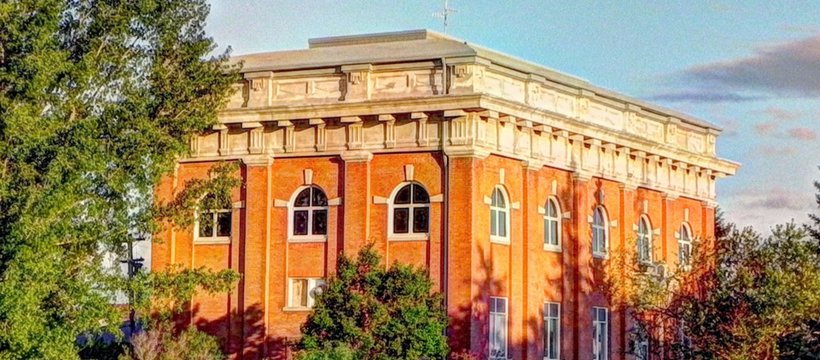Impact
Our ReachSuccess Stories
iheartculture.ca
What is Culture?
Cultural Benefits
E-Update
News
Careers in Culture
Important and Commemorative Days

Opera house inspires community's culture planning
Cultural Areas
Heritage
A shrine to Saskatchewan’s rich history, the Town of Battleford has moved its historic Town Hall/Opera House onto centre stage as part of its most recent municipal cultural plans.
Built in 1912, the Battleford Town Hall/Opera House is a three-story, brick building with a metal roof and crown-jewel- design replica windows. A common sight on the prairies in the early 1900s, only a few of these buildings remain in existence today.
Besides being tied to the historical beginnings of the town, the Opera House was valued for its role in accommodating opera, school plays, high school graduations, live theatre, musical talent nights, Christmas concerts, dances and banquets in the community. In 1965, a fire caused extensive damage to the building. While the lower level was renovated, the upper-level opera house was left vacant and unusable.
Dean Bauche, local consultant and former director of the Allan Sapp Gallery, was hired in 2011 to assist in determining how to proceed with turning the space into a cultural facility. According to Bauche, “Although there was talk over the years about renovation, no formal progress was made until 2009, when Mayor Chris Odishaw recognized the opportunity and initiated a process to obtain the community’s input on what could be done with the facility.”
The Opera House has always been recognized for its historical value. “The construction of opera houses during this period is representative of the cultural aspirations of the people of the area,” says Bauche. The building was known for its extraordinary acoustics for performing arts and providing a gathering place for the community.
Initially, Bauche connected with the cultural community in Battleford. He began working with Safira LaChapel and Kjelti Anderson of Common Ground Collective, a group of individual artists and arts organizations in the area who were establishing their own vision and goals, and were eager to see the Opera House become a cultural facility that would help mobilize and stimulate creative arts in the area. The alliance applied for and received a Capacity Building Grant from SaskCulture that enabled them embark on community consultation.
Consultations began with a very successful, invite-only viewing of the Opera House facility. “Many people in the community had never seen the inside of the building before,” explains Bauche. Out of 200 invites, over 150 people showed up for the first consultation.
“They were amazed at the potential,” adds Bauche. “There were many sighs of ‘oh, my goodness,’ when visitors saw the 4,000 sq. ft. facility, its arch-enhanced stage, hardwood flooring, 22 ft. high ceilings…which provided impeccable acoustics. It had people imagining the possibilities, and saying, ‘Who wouldn’t want to perform in this type of facility?’”
After the viewing and hearing an overview of the project, about 70 people turned out to attend three facilitated sessions that focused on performing arts, visual arts, and patrons of the arts. “We got a snap shot of which people and organizations saw a role for the Opera House and how it could work with other institutions,” he says.
There was substantial interest in aiming for a first class venue for performing and visual artists, he says, where home-grown, community arts and culture could thrive in a heavily utilized facility.
The community consultation process proved extremely successful. A survey conducted at the time resulted in 98-99% support for turning the Opera House into a new cultural facility in Battleford. “We were flabbergasted at the tremendous buy-in from the community,” says Bauche. “The cultural organizations in Battleford don’t really have a home and often have to find other facilities for their purposes.”
Following an extensive consultation, Bauche began dialogue with the facility’s architects, RBM Architecture to determine final changes that will turn the century-old Opera House into a 21st Century cultural facility. RMB Architecture has already won an award for the first phase of their work on the Opera House, replacing the building's roof in 2009. “The architects said it was one of the finest examples of existing Opera Houses in the country,” remarks Bauche. The architects’ Phase III plan includes the incorporation of a tower, built in the same period architecture as the Town Hall/Opera House. The new tower would enable the building to include an elevator, washrooms, serving kitchen as well as providing a viewing deck that offers 365 degree views of the picturesque and historically significant regional geography.
“The town of Battleford is very supportive of not only the restoration of a heritage building,” says Bauche, “but the intention of making it into a cultural facility as well. In fact, the mayor and councillors participated in the community consultation sessions, as participants. The Mayor of North Battleford and one of his councillors were also able to attend a few sessions as well.”
Bauche feels the project is going well. Thanks to a Municipal Cultural Engagement and Planning Grant from SaskCulture, supported by Saskatchewan Lotteries, “We are putting together the pieces of the puzzle,” explains Bauche. The project is now able to move forward to gather information from experts in acoustics, theatre, galleries and programming and others. The initial work was also a very important requirement for positioning ourselves to receive federal funding from the Canada Cultural Spaces Program.
Bauche feels strongly that success will be based on whether people from the community see their vision in the final outcome. “Eight out of ten contributors to the process have found their way into the final report,” he says. “So, I’m confident that the community’s view has been reflected and they will be pleased with the results.”
